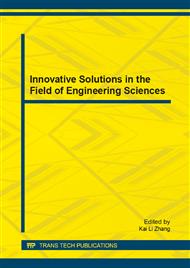[1]
J. Vivancos, et., 2005. Analysis of factors affecting the high-speed side milling of hardened diesteels. Journal of Materials Processing Technology. Vol. 162–163, 200, p.696–701.
DOI: 10.1016/j.jmatprotec.2005.02.155
Google Scholar
[2]
A.F. Ibraheem, et., 2008. Prediction of cutting forces by using machine parameters in end milling process. Engineering and Technology. Vol. 26, No. 11, pp.256-261.
Google Scholar
[3]
K.A. Abou-El-Hossein, et., 2007. Prediction of cutting force in end-milling operation of modified AISI P20 tool steel. Journal of Materials Processing Technology. Vol. 182, p.241–247.
DOI: 10.1016/j.jmatprotec.2006.07.037
Google Scholar
[4]
P. Franco, et., 2004. Influence of radial and axial runouts on surface roughness in face milling with round insert cutting tools. International Journal of Machine Tools & Manufacture. Vol. 44, p.1555–1565.
DOI: 10.1016/j.ijmachtools.2004.06.007
Google Scholar
[5]
E. S. Topal., 2009. The role of step overratioin prediction of surface roughness in flat end milling. International Journal of Mechanical Sciences. Vol. 51, 782–789.
DOI: 10.1016/j.ijmecsci.2009.09.003
Google Scholar
[6]
P. Janmanee, S. Wonthaisong, R. Saodaen, and S. Ithisoponakul., 2014. Surface Roughness of Mold Steel AISI-P20 and AISI-1050 During Milling Machining. The 5th KKU International Engineering Conference 2014. Khon Kaen, Thailand, March 27-29.
DOI: 10.4028/www.scientific.net/amr.931-932.333
Google Scholar
[7]
W.Y.H. Liew, X. Ding., 2008. Wear progression of carbide tool in low-speed end milling of stainless steel. Wear. Vol. 265, 2008, p.155–166.
DOI: 10.1016/j.wear.2007.09.003
Google Scholar
[8]
P. Franco, M. Estrems, F. Faura., 2004. Influence of radial and axial runouts on surface roughnessin face milling with round insert cutting tools. International Journal of Machine Tools & Manufacture. Vol. 44, p.1555–1565.
DOI: 10.1016/j.ijmachtools.2004.06.007
Google Scholar
[9]
S. Dolinek, B. Sustarsi, J. Kopa., 2001. Wear mechanisms of cutting tools in high-speed cutting processes. Wear. Vol. 250, p.349–356.
DOI: 10.1016/s0043-1648(01)00620-2
Google Scholar
[10]
J. Sun, Y.B. Guo., 2008. A new multi-view approach to characterize 3D chip morphology and properties in end milling titanium Ti-6Al-4V. International Journal of Machine Tools & Manufacture 48, 1486– 1494.
DOI: 10.1016/j.ijmachtools.2008.04.002
Google Scholar
[11]
W.Y.H. Liew, X. Ding., 2008. Wear progression of carbide tool in low-speed end milling of stainless steel. Wear 265, 155–166.
DOI: 10.1016/j.wear.2007.09.003
Google Scholar
[12]
A. Aramcharoen, P.T. Mativenga, S. Yang, K.E. Cooke, D.G. Teer., 2008. Evaluation and selection of hard coatings for micro milling of hardened tool steel. International Journal of Machine Tools & Manufacture 48, 1578-1584.
DOI: 10.1016/j.ijmachtools.2008.05.011
Google Scholar


